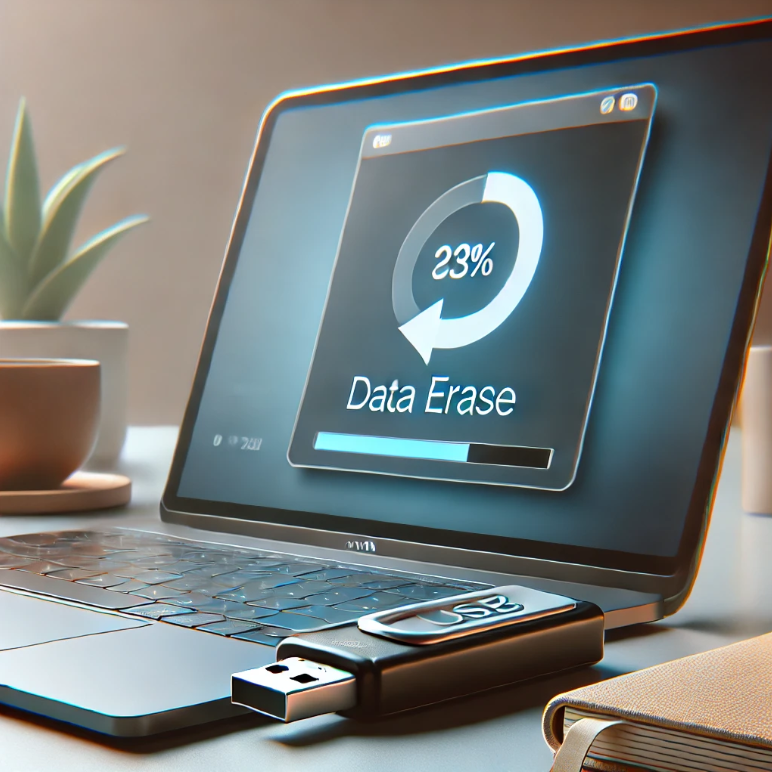In our digital age, USB flash drives have become essential tools for data storage and transfer. However, many users underestimate the significance of properly erasing data from these devices. When you simply delete files or format the drive, remnants of your data often linger, potentially exposing sensitive information. Therefore, a comprehensive approach to data erasure is crucial for protecting your privacy and ensuring that your data is truly irretrievable. This guide will provide you with an informative tutorial on how to effectively erase data from USB flash drives.

Understanding Data Deletion: What Happens When You Delete Files
Before diving into the erasure methods, it’s vital to understand how data deletion works. When you delete a file on your USB flash drive, whether through the operating system’s delete function or a format, the system only removes the file references from the file system. While the data itself remains on the drive, the operating system marks the space as available, making it invisible to the user. This lack of permanent deletion poses risks, particularly for sensitive personal and business information.
Moreover, sophisticated data recovery tools can often reconstruct these seemingly deleted files. This potential for data retrieval highlights the need for effective data-erasure techniques. Understanding this issue is the first step in ensuring you properly erase data from USB flash drives.
Choosing the Right Tools: Software for Secure Erasure
Now that we understand the implications of incomplete data deletion, we need to equip ourselves with the right tools for secure data erasure. Fortunately, various software programs cater to this requirement. These programs utilize advanced algorithms designed to overwrite existing data, making recovery nearly impossible. Popular options include Eraser, CCleaner, and DBAN.
When selecting the right software, consider your specific needs. For example, Eraser is excellent for users seeking a robust open-source option, while CCleaner offers a user-friendly interface suitable for beginners. Regardless of what you choose, ensure it is compatible with your USB device and operating system to facilitate a smooth process.
Step-by-Step USB Data Erasure Process
Having chosen your software, it is time to execute the data-erasure process. The following tutorial outlines essential steps to effectively erase data from USB flash drives:
- Connect your drive: Insert your USB flash drive into the computer and ensure it is recognized by the operating system.
- Launch the erasure software: Open the data-erasure software you selected earlier. Familiarize yourself with its interface to navigate effectively.
- Choose your USB drive: Identify your USB flash drive within the software. Be cautious at this stage, as selecting the wrong drive may lead to unintended data loss.
- Select the erasure method: Most software provides multiple overwriting options. Choose a method based on your needs; for instance, a single-pass overwrite may suffice for general use, while more sensitive data may require a triple-pass method.
- Initiate the erasure: Confirm your selection and start the erasure process. Depending on the size of your USB drive and the method chosen, this may take some time.
- Verify completion: Once the process finishes, some software will provide a verification option to ensure data has been successfully erased. If available, make sure to complete this step.
Alternative Methods: Physical Destruction & Full Format
While software solutions are effective, some users might prefer alternative methods for erasing USB flash drive data. One of the most drastic options is physical destruction. This method is particularly viable for drives containing highly sensitive information that you want to ensure is irretrievable. Physical destruction can involve dismantling the drive or using methods such as shredding or drilling holes through the device.
Another option is performing a full format of your USB drive. Unlike quick formatting, which merely removes file references, a full format scans for bad sectors and can help remove data more thoroughly. However, it’s essential to couple this method with data overwriting for optimal results, as remnants may still be recoverable.
Importance of Data Wiping for Disposal or Repurposing
If you plan to dispose of or repurpose your USB flash drive, securely erasing the data is indispensable. Failing to do so can expose your personal or organizational data to third parties. Whether you intend to sell the drive, give it away, or recycle it, a complete and secure data wipe is crucial.
Ensuring that your sensitive information cannot fall into the wrong hands helps build a robust data protection strategy. Moreover, adopting these best practices not only safeguards your data but also elevates your reputation for responsible technology use.
Best Practices for Data Security and Management
As a best practice for responsible USB drive management, regularly assess and manage the data stored on these devices. Create a habit of securely erasing files before removing them from your system or transferring them to another drive. Furthermore, consider employing encryption tools for sensitive files. Encrypting data adds an additional layer of security, ensuring that even if data recovery occurs, unauthorized individuals remain locked out.
Additionally, familiarize yourself with the available data safety regulations that are relevant to your field. Understanding legal considerations can enhance your data management practices and ensure compliance with applicable laws regarding data erasure.
Conclusion: Make Data Security a Priority
In conclusion, erasing data from USB flash drives must be approached with diligence and care. By using the appropriate software, adhering to a thorough erasure process, and considering alternative methods, you can rest assured that your data remains secure. Remember, the need for secure data deletion extends beyond USB flash drives. You must cultivate a comprehensive awareness of data security across all devices and storage options. Prioritize your data protection today to safeguard your future.